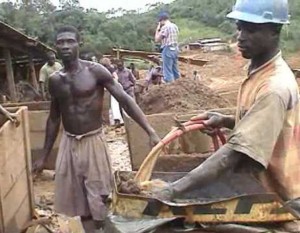Australia supports training of small-scale miners
 The University of Mines and Technology (UMaT) in collaboration with the Australian High Commission has launched a training programme for small-scale miners in Ghana.
The University of Mines and Technology (UMaT) in collaboration with the Australian High Commission has launched a training programme for small-scale miners in Ghana.
The three-month training programme, which is being funded by the Australian High Commission at the cost of AU$ (Australian Dollars) 60,000, aims at teaching good practices in surveying, prospecting, mining, mineral extraction and environmental and safety management to small scale miners.
It would consist of six training modules for miners in nine small-scale districts such as Bolgatanga, in the Upper East; Asankragua, Tarkwa and Bibiani in the Western; and Okyim Oda in the Eastern Region.
The programme had been designed under the terms of a memorandum of understanding (MoU) between the UMaT and the Ghana National Association of Small-Scale Miners (GASSM).
Speaking at the launch in Accra on Tuesday, the Acting Australian High Commissioner to Ghana Tim Millikan said: “Small-scale mining has grown substantially in Ghana, and is now estimated to account for around 30 per cent of total gold production.”
“It is crucial to provide small-scale miners with training in best practices in order for them to conduct activities in a responsible and sustainable manner,” he added.
The Australian Direct Aid Programme is aimed at alleviating poverty through funding grassroots community development projects.
Through this programme, the Australian High Commission in Ghana would provide AU$ 810,000 for projects in the 2015-16 financial year.
The Acting High Commissioner said these projects were in addition to Australia’s existing development cooperation throughout the region.
In 2015-16, the Australian High Commission is funding around 20 projects through the Direct Aid Program.
These projects are benefiting communities in Ghana as well as in Burkina Faso, Côte d’Ivoire, Liberia, Mali, Senegal, Sierra Leone and Togo.
Nii Osah Mills, Minister of Lands and Natural Resources, lauded the Australian Government and UMaT for the novelty.
He urged UMaT to incorporate into the training programmes modules for small-scale miners; the need for them to pay taxes on the revenue they generate from mining.
On the importance of mining, Nii Osah Mills said it creates direct jobs of about one million people leading to income generation and livelihoods for the families and dependents of miners, as well.
“This is especially the case; as mining incomes often tend to be higher than in other sectors readily available within their local areas,” he said.
He said mining induces the development of independent non-mining businesses such as the mental and industrial enclave of Suame; which become the basis for further socio-economic activities that may outlast mining.
He said there was the need for all small-scale miners to be made to sign reclamation bonds; so that the area of their concession would be restored to its origin after mining.
Professor Jerry S. Y. Kuma, the Vice Chancellor, UMaT, said since the regularization of small-scale mining in Ghana in 1989, the number of registered small-scale miners had grown to over 650.
“The contribution of small-scale miners to national gold production has also grown from a low of 2.2 per cent in 1989 to a high of 34 per cent in2015,” he stated.
“This shows that the sector is contributing immensely to national development. Small-scale mining has made significant socio-economic impact on many individuals and communities since it provides both part- and full-time jobs for the people, and in some cases it is the only source of income available,” the Vice Chancellor added.
He said the environmental challenges of the sector were well documented and continued to be of serious concern to stakeholders.
Mr Collins Osei Kusi, the President of GNASSM, in an interview with the Ghana News Agency, described the signing of the MOU as a step in the right direction.
He said small-scale miners were able to extract only 30 per cent of the gold from the ore; explaining that going through the training programme at UMaT would empower them to increase their extraction capacity probably to 90 per cent.
Source: GNA
